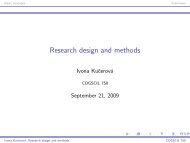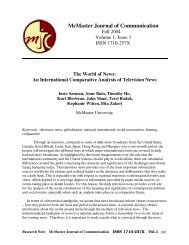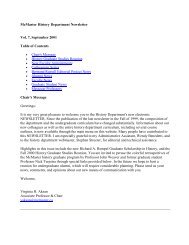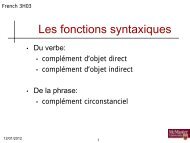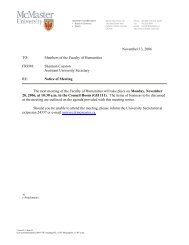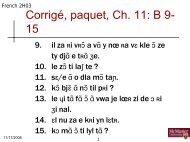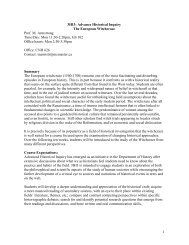The Syntax of Givenness Ivona Kucerová
The Syntax of Givenness Ivona Kucerová
The Syntax of Givenness Ivona Kucerová
You also want an ePaper? Increase the reach of your titles
YUMPU automatically turns print PDFs into web optimized ePapers that Google loves.
Notice that there is no optionality in the word order <strong>of</strong> given elements in a sentence<br />
with a particular meaning. Thus, we need to have a restrictive syntactic system that would<br />
account for the word order. I argue that given elements undergo a special kind <strong>of</strong> movement<br />
that I will call G-movement. <strong>The</strong> rules governing G-movement are given in (11). Further<br />
restrictions on G-movement are stated in (12).<br />
(11) G-Movement [version 1]<br />
G-movement must take place<br />
a. iff α G is asymmetrically c-commanded by a non-G element,<br />
b. unless the movement is independently blocked.<br />
(12) Restrictions on G-movement:<br />
G-movement is restricted as follows:<br />
a. α G moves to the closest position X, such that no non-G element asymmetrically<br />
c-commands α G .<br />
b. If α is XP, then α moves to an XP position.<br />
c. If α is a head, then α moves to an X 0 position.<br />
(13) Closeness: (after Rizzi (1990))<br />
X is the closest to Y only if there is no Z such that Z c-commands Y and does not<br />
c-command X.<br />
Following Reinhart 1997, 2006; Fox 1995, 2000, I argue that G-movement is a syntactic<br />
operation that takes place only if it affects one or both <strong>of</strong> the interfaces. In particular, I<br />
argue that G-movement must have semantic import. In other words, the grammar I argue<br />
for is restricted by economy in that it allows only syntactic operations that lead to a<br />
distinct semantic interpretation. Notice that if there is no non-G element asymmetrically<br />
c-commanding α G the closest position that satisfies the requirement on G-movement is the<br />
position <strong>of</strong> α G itself. Thus, if there is no structurally higher new element, α G does not<br />
move.<br />
<strong>The</strong> definition <strong>of</strong> G-movement implies that an element does not enter the computation<br />
marked as given but it is only the result <strong>of</strong> the computation that the element is interpreted as<br />
such. As we will see in 1.5, this property is crucially connected to the fact that G-movement<br />
is a last resort operation.<br />
Furthermore, (11) crucially relies on the notion <strong>of</strong> asymmetrical c-command (Kayne,<br />
1994) 11 and it does not distinguish heads from phrases, in the sense that both heads and<br />
11 <strong>The</strong> relevant definitions are given below:<br />
(i) X asymmetrically c-commands Y iff X c-commands Y and Y does not c-command X. (Kayne, 1994,<br />
p. 4, (2))<br />
(ii)<br />
X c-commands Y iff X and Y are categories and X excludes Y and every category that dominates X<br />
dominates Y. (Kayne, 1994, p. 16, (3))<br />
(iii) In the sense <strong>of</strong> Chomsky 1986, p. 9: X excludes Y if no segment <strong>of</strong> X dominates Y. (Kayne, 1994, p.<br />
133, ftn.1)<br />
14





